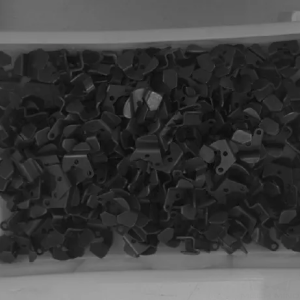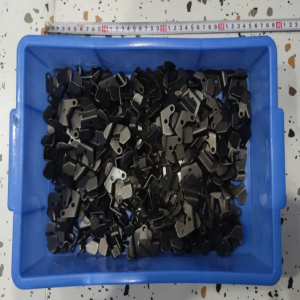Basics
This section introduces the basic information about the Small Sheet Metal Parts solution, including its applicability, advantages, technical specifications, etc.
Applicability
The table below introduces the applicability of the Small Sheet Metal Parts solution in terms of object types, object materials, placement, carriers, etc.
| Feasible | Illustration | |
|---|---|---|
Object type |
Small sheet metal parts of different specifications |
|
Object material |
Non-reflective or slightly reflective |
|
Placement |
Randomly arranged |
|
Object carrier |
Shallow bin |
|
Solution Advantages
The advantages of this solution are as follows:
-
Suitable for picking sheet metal parts of different specifications.
-
The intelligent planning of the picking sequence and picking method enables a stable picking of randomly stacked sheet metal parts.
-
The overall productivity can be improved with 3D vision-guided robot picking.
-
By exploring typical cases in the software with the guidance of this document, beginner engineers can quickly deploy a vision solution.
Technical Specifications
The following table describes the technical specifications of the solution.
| Positioning accuracy | Recognition success rate | Execution time of vision system | Bin clearance rate | Tuning duration |
|---|---|---|---|---|
±2 mm |
More than 99% |
Less than 3 s |
More than 97% |
8h×2 (single type target object)
|
|
The execution time of the vision system refers to the duration from capturing the image to outputting the target object pose. |
Project Difficulties
The difficulties of this solution are as follows:
-
Random stacked: The bent sheet metal parts with complex structures are randomly stacked in the bin. Since the sheet metal parts are interlinked or reflective and the camera imaging is susceptible to environmental factors, the vision system is required to generate high-quality point clouds and calculate the poses of the sheet metal parts.
-
Path Planning: For randomly stacked sheet metal parts, considering the robot path constraints, collision avoidance, and other factors, the appropriate robot tool and pick points should be selected to ensure the bin clearance rate.
-
Flexible and easy to use: Suitable for picking sheet metal parts of different specifications. The vision solution needs to be easy to deploy while meeting user requirements for efficiency, cost control, and other factors.



